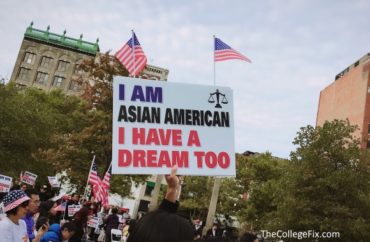
Non-race preferences deserve ‘healthy doses of public shame’
Even though the target of an anti-Asian discrimination lawsuit against Harvard University is its race-based affirmative action system, the case is shining an unwanted spotlight on its other systems of preference.
It turns out they look just as unfair to Asian-American applicants as the practices targeted in the lawsuit.
Robert VerBruggen at National Review analyzes a new report by the expert witness for the plaintiffs that digs deep into the admissions data Harvard was forced to hand over – U.S.-based applications from fall 2009 through fall 2014.
Duke University economist Peter Arcidiacono and two co-authors, Josh Kinsler of the University of Georgia and Tyler Ransom of the University of Oklahoma, focused on four preference categories, known together as ALDCs: “recruited athletes, legacies, those on the dean’s interest list, and children of faculty and staff.”
Admitted whites are nearly three times more likely than admitted African Americans, Asian Americans and Hispanics to be ALDCs, and roughly three in four white ALDCs “would have been rejected if they had been treated as white non-ALDCs,” the abstract reads.
VerBruggen says the report shows “how a prestigious, progressive institution departs from meritocracy to reward the wealthy and connected,” and even if these practices are legal, they deserve “healthy doses of public shame.”
The “LDCs” (the three non-athlete categories) appear to be 20 percent of admissions and athletes another 10 percent – the latter a reflection of Harvard’s “42 Division I sports teams,” he writes:
In the authors’ analysis, legacies experience several times higher odds of admission than do otherwise similar applicants from less favored lineages. Those on the dean’s list are especially preferred. Recruited athletes have an astounding 86 percent chance of getting in despite relatively weak academic records. (Such strong athlete preferences are why the recent admissions scandal involved bribing coaches at several schools.)
Yet it’s a fallacy to claim that whites would be admitted in far lower numbers without ALDC preferences, VerBruggen continues. The paper’s numbers show “white admissions would fall by just 4 percent without legacy preferences and 6 percent without athlete preferences.”
The real loser in Harvard’s various preference systems is still Asian Americans, who would recoup “the largest number of abandoned seats” if legacy and athlete preferences were removed.
Add racial preferences to the elimination list and the Asian-American benefit is staggering: 50 percent higher admissions. Whites would get 3 percent more seats and the two other major categories would “crater dramatically,” VerBruggen says: two-thirds fewer blacks and 40 percent fewer Hispanics.
“[T]hose of us who detest racial preferences should despise legacy preferences twice as much,” because they are not only anti-meritocratic but exist “merely to heap more donations” on Harvard’s obscene endowment and cultivate “an amorphous sense of community” around sports teams and long-graduated alumni.
Read the article and new report.
Like The College Fix on Facebook / Follow us on Twitter




Add to the Discussion